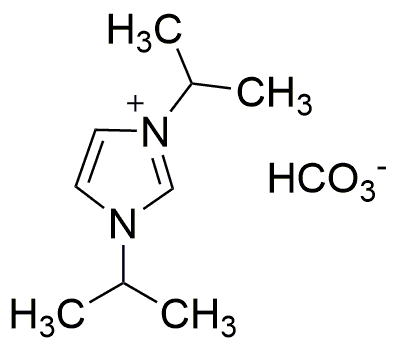1,3-Diisopropylimidazolium hydrogencarbonate is widely utilized in research focused on:
- Green Chemistry: This compound serves as a solvent and catalyst in various organic reactions, promoting environmentally friendly processes by reducing the need for toxic solvents.
- Electrolytes in Energy Storage: It is used in the development of advanced electrolytes for batteries and supercapacitors, enhancing energy efficiency and storage capacity.
- Biomass Conversion: The compound plays a crucial role in the conversion of biomass into biofuels, improving yield and efficiency in renewable energy production.
- Pharmaceutical Applications: It is explored for its potential in drug formulation and delivery systems, providing improved solubility and bioavailability for active pharmaceutical ingredients.
- Carbon Capture Technologies: This chemical is being investigated for its ability to capture carbon dioxide, contributing to efforts in reducing greenhouse gas emissions and combating climate change.
General Information
Properties
Safety and Regulations
Applications
1,3-Diisopropylimidazolium hydrogencarbonate is widely utilized in research focused on:
- Green Chemistry: This compound serves as a solvent and catalyst in various organic reactions, promoting environmentally friendly processes by reducing the need for toxic solvents.
- Electrolytes in Energy Storage: It is used in the development of advanced electrolytes for batteries and supercapacitors, enhancing energy efficiency and storage capacity.
- Biomass Conversion: The compound plays a crucial role in the conversion of biomass into biofuels, improving yield and efficiency in renewable energy production.
- Pharmaceutical Applications: It is explored for its potential in drug formulation and delivery systems, providing improved solubility and bioavailability for active pharmaceutical ingredients.
- Carbon Capture Technologies: This chemical is being investigated for its ability to capture carbon dioxide, contributing to efforts in reducing greenhouse gas emissions and combating climate change.
Documents
Safety Data Sheets (SDS)
The SDS provides comprehensive safety information on handling, storage, and disposal of the product.
Product Specification (PS)
The PS provides a comprehensive breakdown of the product’s properties, including chemical composition, physical state, purity, and storage requirements. It also details acceptable quality ranges and the product's intended applications.
Certificates of Analysis (COA)
Search for Certificates of Analysis (COA) by entering the products Lot Number. Lot and Batch Numbers can be found on a product’s label following the words ‘Lot’ or ‘Batch’.
*Catalog Number
*Lot Number
Certificates Of Origin (COO)
This COO confirms the country where the product was manufactured, and also details the materials and components used in it and whether it is derived from natural, synthetic, or other specific sources. This certificate may be required for customs, trade, and regulatory compliance.
*Catalog Number
*Lot Number
Safety Data Sheets (SDS)
The SDS provides comprehensive safety information on handling, storage, and disposal of the product.
DownloadProduct Specification (PS)
The PS provides a comprehensive breakdown of the product’s properties, including chemical composition, physical state, purity, and storage requirements. It also details acceptable quality ranges and the product's intended applications.
DownloadCertificates of Analysis (COA)
Search for Certificates of Analysis (COA) by entering the products Lot Number. Lot and Batch Numbers can be found on a product’s label following the words ‘Lot’ or ‘Batch’.
*Catalog Number
*Lot Number
Certificates Of Origin (COO)
This COO confirms the country where the product was manufactured, and also details the materials and components used in it and whether it is derived from natural, synthetic, or other specific sources. This certificate may be required for customs, trade, and regulatory compliance.


